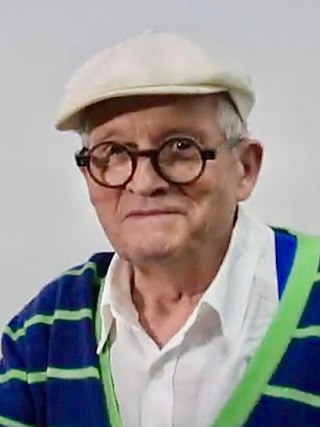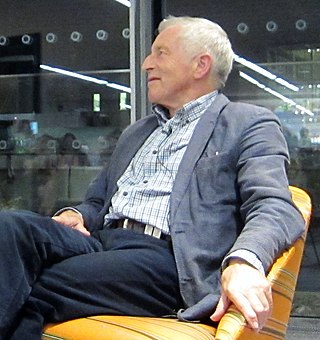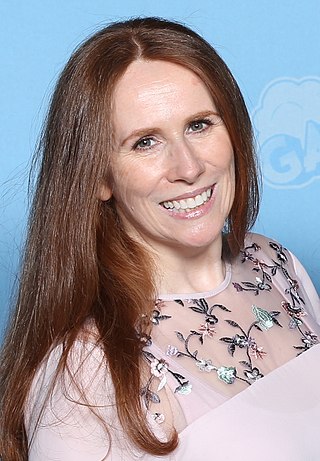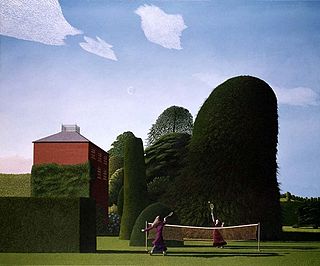
Sir John Everett Millais, 1st Baronet was an English painter and illustrator who was one of the founders of the Pre-Raphaelite Brotherhood. He was a child prodigy who, aged eleven, became the youngest student to enter the Royal Academy Schools. The Pre-Raphaelite Brotherhood was founded at his family home in London, at 83 Gower Street. Millais became the most famous exponent of the style, his painting Christ in the House of His Parents (1849–50) generating considerable controversy, and he produced a picture that could serve as the embodiment of the historical and naturalist focus of the group, Ophelia, in 1851–52.

Laurence Stephen Lowry was an English artist. His drawings and paintings mainly depict Pendlebury, Greater Manchester as well as Salford and its vicinity.

David Hockney is an English painter, draughtsman, printmaker, stage designer, and photographer. As an important contributor to the pop art movement of the 1960s, he is considered one of the most influential British artists of the 20th century.

Little Britain is a British sketch comedy series that began as a radio show in 2000 and ran as a television series between 2003 and 2006. It was written and performed by David Walliams and Matt Lucas. Financed by the BBC, the radio series was first broadcast on BBC Radio 4, with the initial two television series premiering on BBC Three and the third and final series on BBC One.
Graham Vivian Sutherland was a prolific English artist. Notable for his paintings of abstract landscapes and for his portraits of public figures, Sutherland also worked in other media, including printmaking, tapestry and glass design.

David Dimbleby is an English journalist and former presenter of current affairs and political programmes, best known for having presented the BBC topical debate programme Question Time. He is the son of broadcaster Richard Dimbleby and elder brother of Jonathan Dimbleby, of the Dimbleby family. Long involved in the coverage of national events, Dimbleby hosted the BBC Election Night coverage from 1979 to 2017, as well as United States presidential elections on the BBC until 2016. He has also presented and narrated documentary series on architecture and history.

Frederick Richard Dimbleby was an English journalist and broadcaster, who became the BBC's first war correspondent, and then its leading TV news commentator.

Jonathan Dimbleby is a British presenter of current affairs and political radio and television programmes, author and historian. He is the son of Richard Dimbleby and younger brother of television presenter David Dimbleby.

Question Time is a topical debate programme, typically broadcast on BBC One at 10:45 pm on Thursdays. It is usually repeated on BBC Two and on BBC Parliament later in the week. If there is a Leaders special, it would be broadcast simultaneously on BBC News. Question Time is also available on BBC iPlayer. Fiona Bruce currently chairs the show having succeeded David Dimbleby as presenter in January 2019.

The Hon. Sir Nicholas Andrew Serota,, is a British art historian and curator.

The Hay Wain – originally titled Landscape: Noon – is a painting by John Constable, completed in 1821, which depicts a rural scene on the River Stour between the English counties of Suffolk and Essex. It hangs in the National Gallery in London and is regarded as "Constable's most famous image" and one of the greatest and most popular English paintings.

Paul Nash was a British surrealist painter and war artist, as well as a photographer, writer and designer of applied art. Nash was among the most important landscape artists of the first half of the twentieth century. He played a key role in the development of Modernism in English art.

Catherine Jane Ford, known professionally as Catherine Tate, is a British actress, comedian and writer. She has won numerous awards for her work on the BBC sketch comedy series The Catherine Tate Show (2004–2007), as well as being nominated for an International Emmy Award and seven BAFTAs. Tate played Donna Noble in the 2006 Christmas special of Doctor Who, and later reprised her role for the fourth series in 2008, and the 60th anniversary episodes in 2023.

The Catherine Tate Show is a British television comedy sketch programme written by Catherine Tate and Derren Litten featuring a wide range of characters. The Catherine Tate Show aired on BBC Two and was shown worldwide through the BBC. Collectively, the show has been nominated for six BAFTA Awards, two British Comedy Awards and an Emmy Award, and it has won two Royal Television Society Awards, two British Comedy Awards and a National Television Award since its debut in 2004.

Sir Donald McCullin is a British photojournalist, particularly recognised for his war photography and images of urban strife. His career, which began in 1959, has specialised in examining the underside of society, and his photographs have depicted the unemployed, downtrodden and impoverished.

David Inshaw is a British artist who sprang to public attention in 1973 when his painting The Badminton Game was exhibited at the ICA Summer Studio exhibition in London. The painting was subsequently acquired by the Tate Gallery and is one of several paintings from the 1970s that won him critical acclaim and a wide audience. Others include The Raven, Our days were a joy and our paths through flowers, She did not turn, The Cricket Game, Presentiment and The River Bank (Ophelia).

The prehistoric landmark of Stonehenge is distinctive and famous enough to have been frequently referenced in popular culture. The landmark has become a symbol of British culture and history, owing to its distinctiveness and its long history of being portrayed in art, literature, and advertising campaigns; and in more recent media formats such as television, film, and computer games. This is in part because the arrangement of standing stones topped with lintels is unique: not just in the British Isles, but in the world.
How We Built Britain is a series of six television documentaries produced by the BBC in 2007 and repeated in 2008. The series was written and presented by broadcaster David Dimbleby. In the series Dimbleby visits some of Britain's great historic buildings and examined their impact on Britain's architectural and social history.
Thomas West was a Jesuit priest, antiquary and author, significant in being one of the first to write about the attractions of the Lake District. Partly through his book, A Guide to the Lakes, the Romantic vision of the scenery and wilderness of the north of England took hold, ushering in a period of continued tourism in the Lakes.

The Badminton Game is a painting of 1973 by the English painter David Inshaw. It was inspired by the gardens of Devizes and the landscape of Wiltshire. Inshaw has described how the place gave him a feeling of "mystery and wonder". He wrote about the painting: "my main aim was to produce a picture that held a moment in time, but unlike a photograph, which only records an event. I thought a painting could give a more universal, deeper meaning to that moment by composing one instant from lots of different unrelated moments." Its original title was a line from Thomas Hardy's poem "She, to Him": Remembering mine the loss is, not the blame.















